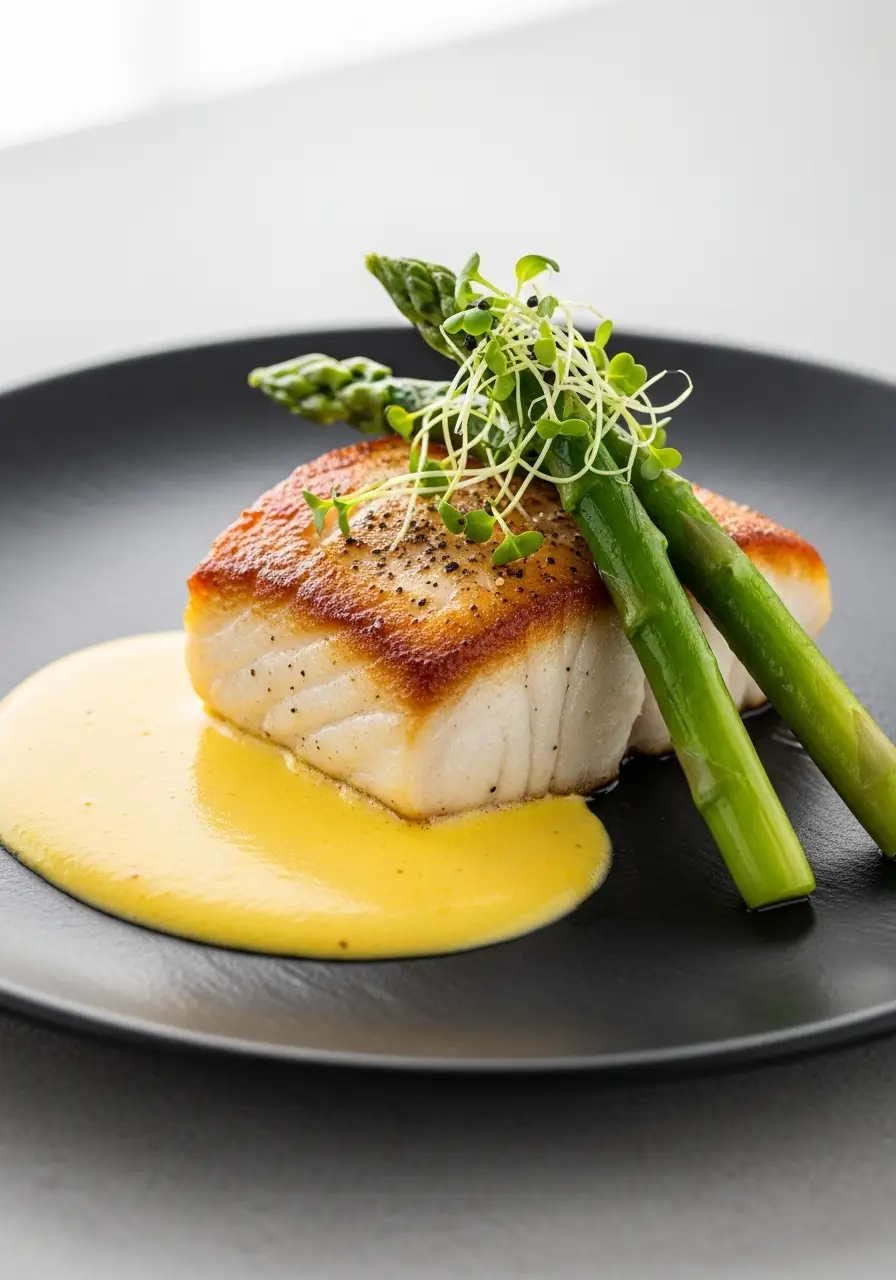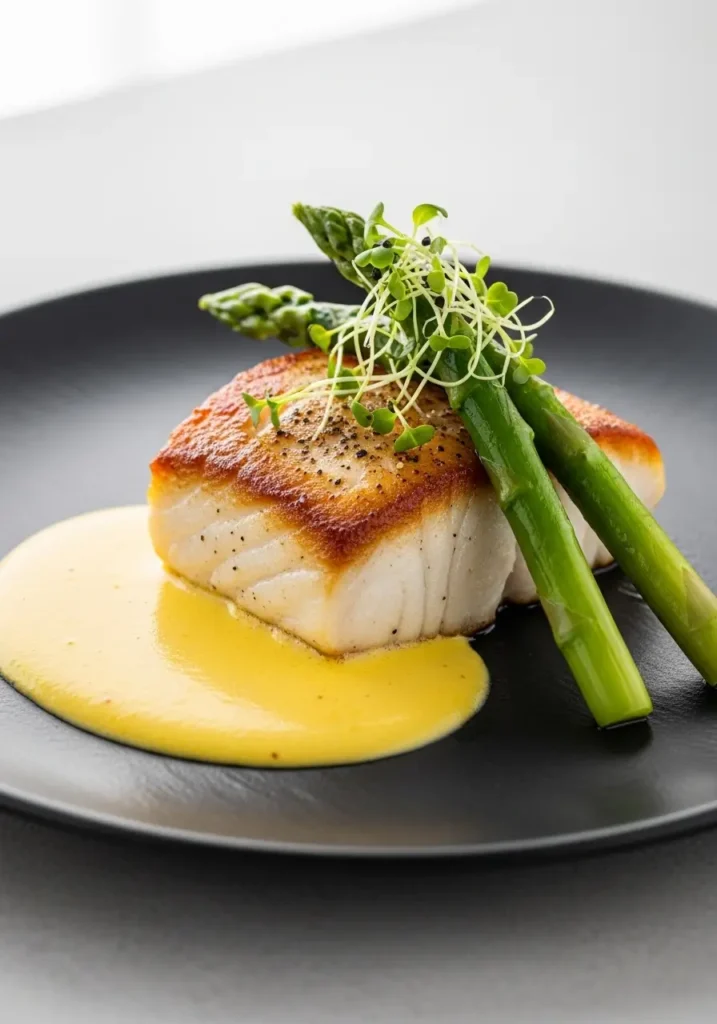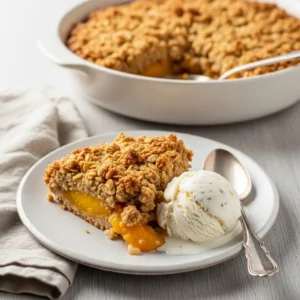Transform your kitchen into a five-star restaurant with this incredible fine dining halibut recipe. If you’ve ever wanted to recreate the magic of a high-end meal at home, this is your chance. We will guide you through creating a perfectly pan-seared halibut with a crisp, golden-brown crust and a moist, flaky interior. The crowning glory is a luxurious, velvety saffron beurre blanc—a classic French butter sauce that is surprisingly simple to master. This elegant dish is perfect for a special occasion, a romantic dinner, or any time you want to impress.
Forget intimidating techniques and complicated steps. This recipe breaks down everything you need to know to cook halibut like a professional chef, from selecting the right fillet to plating with an artistic touch. Get ready to create a meal that looks as stunning as it tastes.
Why This is the Ultimate Fine Dining Halibut Recipe
Many recipes promise restaurant-quality results, but this one truly delivers by focusing on the three pillars that separate a good dish from a gourmet experience. It’s not just about the ingredients; it’s about the technique, the sauce, and the presentation.
- Foolproof Technique: We’ll show you the secrets to achieving a perfect sear every time, ensuring your halibut has that coveted crispy skin and tender, succulent flesh.
- Luxurious, Achievable Sauce: A beurre blanc can sound intimidating, but our step-by-step guide demystifies the process. The addition of saffron elevates it from a simple butter sauce to something truly spectacular.
- Elegant Presentation: We’ll provide simple tips on how to plate this dish beautifully, turning your dinner plate into a canvas.
Key Ingredients for Success
The quality of your ingredients is paramount in a dish this elegant. Here’s what you’ll need:

For the Pan-Seared Halibut
- Halibut Fillets: Look for thick-cut, center-cut halibut fillets, about 1.5 inches thick. This thickness helps prevent the fish from overcooking while you get a beautiful crust. Wild-caught Alaskan halibut is an excellent choice for its firm texture and clean, sweet flavor.
- High-Smoke-Point Oil: Avocado oil or grapeseed oil is ideal for searing at high temperatures without smoking.
- Unsalted Butter: A small amount is added at the end for flavor and browning.
- Sea Salt & Freshly Ground Black Pepper: For simple, perfect seasoning.
For the Saffron Beurre Blanc
- Dry White Wine: A crisp Sauvignon Blanc or Pinot Grigio works best. Never cook with a wine you wouldn’t drink!
- Shallot: Provides a delicate, sweet onion flavor that is essential for the sauce’s base.
- Saffron Threads: Just a small pinch provides incredible color and a unique, aromatic flavor.
- Heavy Cream: This helps stabilize the sauce, making it creamier and less likely to break.
- Cold Unsalted Butter: The butter must be cold and cut into cubes. This is the key to creating a smooth, emulsified sauce.
- Lemon Juice: A fresh squeeze at the end brightens all the flavors.
How to Make This Fine Dining Halibut Recipe (Step-by-Step)
Follow these steps carefully for a flawless result. We recommend making the sauce first, as the fish cooks very quickly.
Step 1: Prepare the Saffron Beurre Blanc
- Reduce Aromatics: In a small saucepan over medium heat, combine the white wine, minced shallot, and saffron threads. Bring to a simmer and let it reduce until only about 2 tablespoons of liquid remain. This concentrates the flavor.
- Add Cream: Pour in the heavy cream and bring back to a simmer for 1 minute. This creates a stable base for the butter.
- Emulsify the Butter: Reduce the heat to low. Begin adding the cold butter cubes one or two at a time, whisking constantly. It is crucial to add the next cube only after the previous one has fully melted and incorporated. Do not let the sauce boil, or it will break.
- Finish the Sauce: Once all the butter is whisked in, the sauce should be smooth, pale yellow, and slightly thickened. Remove from the heat and stir in a squeeze of fresh lemon juice. Season with a pinch of salt. Set aside in a warm place while you cook the fish.
Step 2: Perfectly Sear the Halibut
- Prep the Fish: Pat the halibut fillets completely dry with paper towels. This step is critical for a crispy skin. Season both sides generously with salt and pepper. For more on getting that perfect golden crust, check out our guide to the easiest pan-seared halibut.
- Heat the Pan: Place a large non-stick or carbon steel skillet over medium-high heat. Add the high-smoke-point oil. The pan is ready when the oil shimmers slightly.
- Sear the Halibut: Carefully place the halibut fillets in the hot pan, presentation-side down. Press down gently with a fish spatula for 10 seconds to ensure full contact with the pan. Cook for 4-5 minutes without moving them, allowing a deep golden-brown crust to form.
- Flip and Finish: Flip the fillets. Add 1 tablespoon of butter to the pan. As it melts, tilt the pan and spoon the foaming butter over the fish for about 30 seconds. Continue to cook for another 2-4 minutes, depending on thickness. The fish is done when it flakes easily and reaches an internal temperature of 130-135°F (54-57°C).

Step 3: Plate Like a Pro
- Create a Base: Spoon a generous pool of the warm saffron beurre blanc onto the center of each plate.
- Place the Halibut: Gently place the seared halibut fillet on top of the sauce, with the beautifully crusted side facing up.
- Add Sides: Artfully arrange your chosen sides, like blanched asparagus spears or a small mound of creamy risotto, next to the fish.
- Garnish: Finish with a sprinkle of fresh microgreens or chopped chives and a little lemon zest for a pop of color and freshness.
Chef’s Tips for a Flawless Dish
- Don’t Overcook the Fish: Halibut is a lean fish and can dry out quickly. Use a meat thermometer and pull it from the heat just before it’s fully done. It will continue to cook from residual heat.
- Keep the Sauce Warm: If your beurre blanc gets too cold, it will solidify. If it gets too hot, it will break. Keep it in a warm spot, like near the stovetop, but not directly on a burner.
- Dry Fish is Key: We can’t stress this enough. A dry surface is essential for getting a proper Maillard reaction, which creates that delicious golden crust.
- Use a Fish Spatula: A thin, flexible fish spatula makes flipping the delicate fillets much easier without breaking them.
Elegant Pairing Suggestions
What to Serve with Fine Dining Halibut
To complete your fine dining experience, serve this halibut with sides that complement its delicate flavor without overpowering it.
- Creamy Risotto: A simple parmesan or lemon risotto is a classic pairing.
- Potato Purée: A silky-smooth potato purée is perfect for soaking up the extra sauce.
- Blanched Asparagus or Haricots Verts: Slender green vegetables add a fresh, crisp element and a beautiful splash of color.
- Sautéed Spinach: A simple side of spinach sautéed with garlic is always a great choice.
For a different flavor profile, consider this delicious one-pan Mediterranean halibut with olives and tomatoes.
Wine Pairings
A crisp white wine is the ideal companion for this dish. Look for a bottle of:
- Sauvignon Blanc: Its bright acidity cuts through the richness of the butter sauce.
- Unoaked or Lightly Oaked Chardonnay: Complements the creamy texture of the dish.
- Pinot Grigio: A light and refreshing option that won’t compete with the saffron.

Fine Dining Halibut Recipe with Saffron Beurre Blanc
Learn how to make a restaurant-quality fine dining halibut recipe at home. This recipe features a perfectly pan-seared halibut with a crisp, golden crust, served with a luxurious and surprisingly simple saffron beurre blanc sauce. Perfect for a special occasion dinner.
Ingredients
Equipment
Instructions
- In a small saucepan over medium heat, combine the white wine, minced shallot, and saffron threads. Bring to a simmer and let it reduce until only about 2 tablespoons of liquid remain. This concentrates the flavor.
- Pour in the heavy cream and bring back to a simmer for 1 minute to create a stable base for the butter.
- Reduce the heat to low. Begin adding the cold butter cubes one or two at a time, whisking constantly. Add the next cube only after the previous one has fully melted. Do not let the sauce boil.
- Once all butter is incorporated, remove from heat. Stir in the lemon juice and season with a pinch of salt. Set aside in a warm place.
- Pat the halibut fillets completely dry with paper towels and season both sides generously with salt and pepper.
- Place a large non-stick skillet over medium-high heat. Add the avocado oil. The pan is ready when the oil shimmers.
- Carefully place halibut in the pan, presentation-side down. Cook for 4-5 minutes without moving to form a deep golden-brown crust.
- Flip the fillets. Add 1 tbsp of butter to the pan. Baste the fish with the melting butter for 30 seconds. Cook for another 2-4 minutes, or until the internal temperature reaches 130-135°F (54-57°C).
- Spoon a pool of the warm saffron beurre blanc onto each plate. Place the seared halibut on top, crust-side up. Garnish with microgreens and serve immediately.
Notes
Do not let the sauce boil! This is the most important rule for making beurre blanc. Keeping the heat low and adding the butter slowly is key to a smooth, emulsified sauce.
Use cold butter. Cold butter melts more slowly, which helps it emulsify properly into the sauce rather than just separating into grease.
Rest the fish. Let the halibut rest for a minute or two before plating to allow the juices to redistribute.

Fine Dining Halibut Recipe with Saffron Beurre Blanc
Ingredients
Equipment
Instructions
- In a small saucepan over medium heat, combine the white wine, minced shallot, and saffron threads. Bring to a simmer and let it reduce until only about 2 tablespoons of liquid remain. This concentrates the flavor.
- Pour in the heavy cream and bring back to a simmer for 1 minute to create a stable base for the butter.
- Reduce the heat to low. Begin adding the cold butter cubes one or two at a time, whisking constantly. Add the next cube only after the previous one has fully melted. Do not let the sauce boil.
- Once all butter is incorporated, remove from heat. Stir in the lemon juice and season with a pinch of salt. Set aside in a warm place.
- Pat the halibut fillets completely dry with paper towels and season both sides generously with salt and pepper.
- Place a large non-stick skillet over medium-high heat. Add the avocado oil. The pan is ready when the oil shimmers.
- Carefully place halibut in the pan, presentation-side down. Cook for 4-5 minutes without moving to form a deep golden-brown crust.
- Flip the fillets. Add 1 tbsp of butter to the pan. Baste the fish with the melting butter for 30 seconds. Cook for another 2-4 minutes, or until the internal temperature reaches 130-135°F (54-57°C).
- Spoon a pool of the warm saffron beurre blanc onto each plate. Place the seared halibut on top, crust-side up. Garnish with microgreens and serve immediately.
Notes
Use cold butter. Cold butter melts more slowly, which helps it emulsify properly into the sauce rather than just separating into grease.
Rest the fish. Let the halibut rest for a minute or two before plating to allow the juices to redistribute.
Frequently Asked Questions About Fine Dining Halibut Recipe
Beurre blanc is best made right before serving for the ideal texture. However, you can make the wine and shallot reduction ahead of time. When you’re ready to serve, simply reheat the reduction, add the cream, and then whisk in the cold butter.
This recipe works well with either, but for a true fine-dining presentation, a skinless fillet is often preferred. If you do use skin-on halibut, sear the skin side down first to get it extra crispy.
Elegant sides pair best. We recommend a creamy parmesan risotto, silky potato purée, or simple blanched vegetables like asparagus or haricots verts. These sides complement the rich sauce and delicate fish without overpowering them.
A heavy-bottomed stainless steel, carbon steel, or a high-quality non-stick skillet is best for searing halibut. These pans distribute heat evenly, which is crucial for developing a beautiful, golden-brown crust without sticking.
The best way is to use an instant-read thermometer. Halibut is perfectly cooked when its internal temperature reaches 130-135°F (54-57°C). If you don’t have one, the fish should be opaque and flake easily with a fork. Be careful not to overcook it, as it will become dry.
Storing and Reheating Leftovers
While this dish is best enjoyed immediately, you can store leftovers in an airtight container in the refrigerator for up to 2 days. The sauce should be stored separately.
To reheat, gently warm the halibut in a 275°F (135°C) oven until just heated through. The sauce can be very gently warmed in a saucepan over low heat, whisking constantly. Do not let it boil.
Looking for another show-stopping, restaurant-inspired fish recipe? You have to try this Nobu-inspired Miso Halibut (coming soon).
We Hope You Love This Recipe!
We are confident this fine dining halibut recipe will become a new favorite for your special occasions. It proves that gourmet cooking is accessible and incredibly rewarding. If you make this dish, please leave a comment below to let us know how it turned out! And don’t forget to save it to your favorite board on Pinterest!



